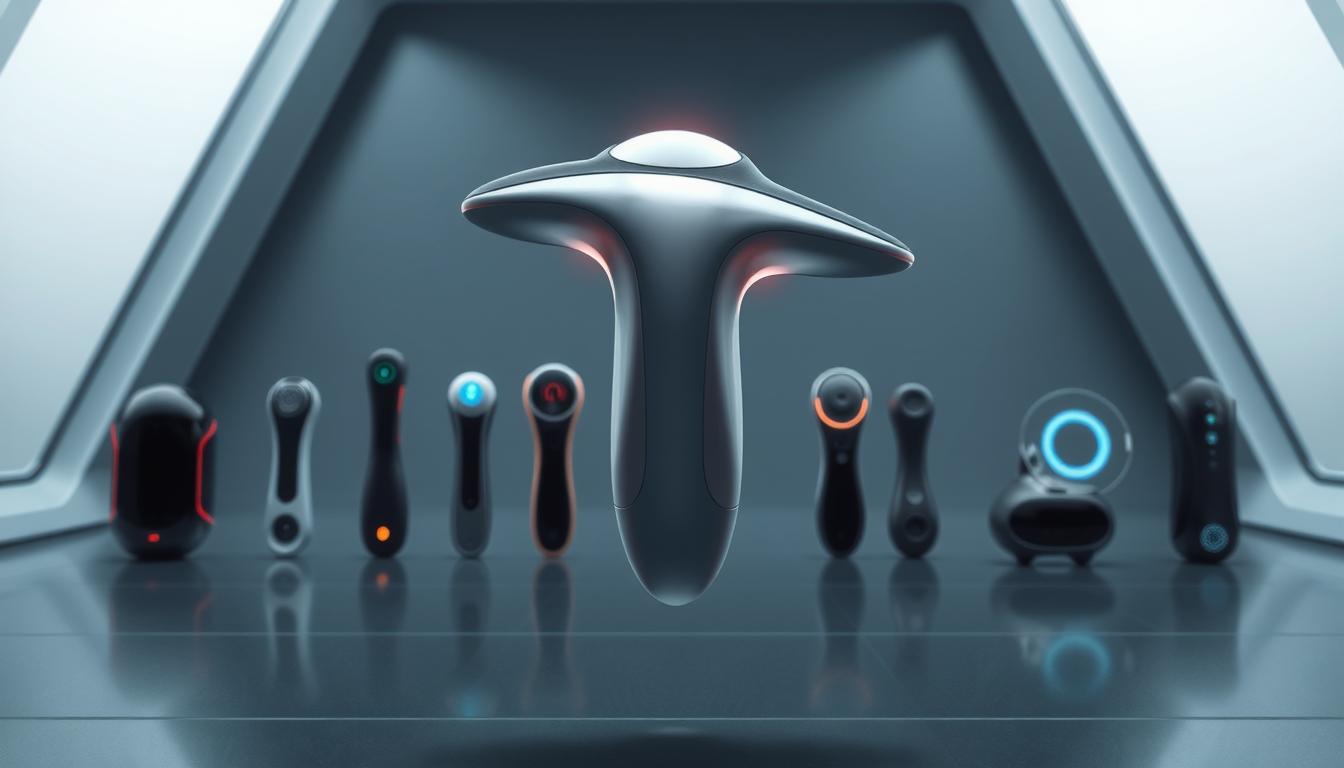The rise of artificial companions sparks curiosity worldwide. Experts predict these innovations could reshape human connections in the coming decades. With rapid advancements, synthetic partners are no longer just sci-fi fantasies.
Recent studies reveal surprising adoption rates. Over 17% of adults have experimented with synthetic companions, according to Bedbible research. The global market now exceeds $35 billion, proving significant demand exists.
Dr. Ian Pearson’s forecast suggests robotic marriages might gain legal recognition by 2050. Meanwhile, users report improved emotional well-being from these unique relationships. The industry continues evolving at 25% annual growth, pushing boundaries daily.
Key Takeaways
- Experts predict robotic companions could achieve mainstream acceptance by mid-century
- Current adoption rates show 2 million active users worldwide
- The synthetic intimacy market generates over $35 billion annually
- Many users report positive emotional impacts from these relationships
- Technological advancements accelerate faster than cultural acceptance
The Current State of Sex Robots: From Fantasy to (Almost) Reality
Modern intimacy devices now blur the line between fantasy and reality. No longer confined to sci-fi, synthetic companions like RealDoll’s Harmony AI and Abyss Creations’ customizable figures offer startling realism. These aren’t static dolls—they’re evolving into interactive partners.
Harmony to Charlotte: A Glimpse into Today’s Sexbots
The $11,000 Harmony AI head learns preferences, while budget-friendly $3,000 models focus on physical realism. Cyrus North’s viral unboxing of *Charlotte*—complete with her quirky Scottish accent—showcased both the potential and awkwardness of these devices.
Customization is king. Buyers choose everything from skin tone to celebrity likenesses. Yet, challenges remain. Manufacturers are tackling 50kg weight limits and improving mobility to enhance user experience.
Market Size and Industry Growth: A Niche or Mainstream?
The industry generates $200 million annually, with 56,000 units sold yearly. While adoption is niche, 72% of single users report reduced loneliness, per Bedbible research. Legal expert Madi McCarthy notes stricter regulations for child-like dolls, highlighting societal concerns.
Advancements suggest a tipping point. As prices drop and AI improves, synthetic companions could transition from curiosity to commonplace. The question isn’t *if* but *how* society will adapt.
How Sex Robots Work: The Tech Behind the Hype
Beneath the silicone skin lies a network of sensors and learning algorithms. These technologies transform lifeless materials into partners that respond to touch and speech. RealBotix leads with tactile simulation systems that adapt to user preferences.
Artificial Intelligence and Learning Algorithms
Modern units like Harmony AI use machine learning to remember favorite phrases or caresses. Microsoft’s Xiaoice chatbot proved emotional bonds form through consistent interaction. Now, that tech lives in physical forms.
Voice assistants influence personality features. Most models default to feminine tones because market research shows comfort with familiar voices. The head houses crucial processors while the body focuses on responsive movement.
Overcoming the Uncanny Valley: Design Challenges
Madeline Ashby predicts anime-style designs may avoid the creep factor. Current models still struggle with fluid motion replication. Nanotech breakthroughs aim to create realistic skin textures that feel warm.
Weight remains a hurdle. Reducing mass by 40kg would help mainstream adoption. Designers balance durability with portability—no easy feat when mimicking human proportions.
From Static Dolls to Interactive Companions
The evolution happens in three phases. Basic silicone figures come first. Next, VR hybrids add digital layers. Finally, full AI integration creates autonomous partners.
Tactile feedback systems simulate body heat and pressure. These subtle details bridge the gap between object and companion. The journey from novelty to necessity accelerates yearly.
Society’s Reaction: Acceptance, Stigma, and Everything in Between
Society remains deeply divided over synthetic companions. While some embrace these innovations, others view them as threats to human connections. This cultural tension reveals fascinating patterns across demographics.
Public Opinion Polls: Who’s Open to Robot Romance?
Tufts University research shows a striking gender gap. About 67% of men expressed willingness to try synthetic partners, compared to just 33% of women. Younger generations show more openness than older adults.
Japan leads adoption rates at 27%, possibly linked to social isolation trends. Surprisingly, 45% of married users report decreased interest in human intimacy. Yet 55% still consider bot interaction as “advanced masturbation.”
The Loneliness Factor: Can Robots Fill Emotional Gaps?
Bedbible’s data reveals 72% of single users experience reduced loneliness. Widowers using replica partners report 38% approval rates for emotional support. These devices appear to address real social needs.
However, critics warn about addiction risks. Studies show 30% dependency potential versus 65% satisfaction rates. Disability advocates champion the technology, while groups like Campaign Against Sex Robots raise ethical concerns.
Gen Z shows particular interest in VR-integrated models. As conversations evolve, so do attitudes toward synthetic relationships. The debate continues balancing innovation with human values.
Ethical Dilemmas: Consent, Objectification, and Legal Gray Areas
Ethical debates swirl around synthetic companions as technology advances. What happens when human desires collide with machine limitations? These discussions touch raw nerves about power, consent, and what it means to connect.

Programming Consent: Can a Robot Say No?
McCarthy and Leiman’s research reveals troubling trends. About 30% of users request “non-consent” programming options. Sinziana Gutiu’s “robotization of consent” theory argues this normalizes harmful behavior.
Flinders University found simulated resistance increases aggression risks. Yet manufacturers face pressure to fulfill fantasies. Some companies now include mandatory ethics modules in AI training.
The Gender Debate: Are Sexbots Reinforcing Harmful Stereotypes?
2021 data shows 89% have female personas. Male-dominated design teams (7:1 ratio) shape these personalities. Many models default to submissive traits, perpetuating stereotypes.
Feminist scholars warn about objectification risks. “We’re coding 1950s ideals into 21st-century tech,” notes sociologist Dr. Lisa Campo. Some brands now offer non-binary options to challenge norms.
Legal Frontiers: Regulating the Uncharted
The UK bans child-like dolls while adult models remain unregulated. EU GDPR rules conflict with US free-market approaches. Celebrity likeness cases expose intellectual property gaps.
Intimacy certification programs may offer solutions. These would verify ethical manufacturing and programming standards. As law struggles to adapt, industry self-regulation gains traction.
The path forward requires balancing innovation with responsibility. By addressing these ethics concerns early, we can shape technology that enhances rather than diminishes human dignity.
When Will Sex Robots Become a Thing? Predictions from Experts
Tech visionaries paint vivid pictures of synthetic relationships reshaping modern life. Their forecasts reveal surprising consensus about adoption timelines, though cultural attitudes lag behind technological capabilities. Let’s examine what leading experts predict for coming decades.
2025-2035: The Rise of Virtual and Physical Companions
The Bondara report suggests virtual reality intimacy will achieve norm status by 2030. Early adopters already use haptic suits with VR platforms, creating immersive experiences. Physical models will transition from luxury items to household appliances.
Current prototypes show remarkable progress. Therapy bots now enter clinical trials, helping couples improve communication. These units analyze speech patterns and suggest conflict resolution strategies.
| Year | Technology | Adoption Rate |
|---|---|---|
| 2025 | Basic AI companions | 18% US adults |
| 2030 | VR intimacy suites | 42% projected |
| 2035 | Autonomous partners | 27% early estimates |
Rob Brooks warns about false intimacy from AI memory systems. “These companion units recall every detail perfectly,” he notes. “That creates unrealistic expectations for human partners.”
2050 and Beyond: Marriage to Robots?
Dr. Ian Pearson’s 2050 marriage timeline gains traction as Japan considers legal recognition. Some Shinto shrines already draft ceremonies for human-machine unions. Tax codes may need updates for multi-bot households.
Religious groups take varied positions. While some embrace synthetic spouses, others call for strict regulations. The Vatican recently formed a task force to study the theological implications.
Cultural acceptance moves slower than tech advancement. Current 15% US usage rates could triple by 2040. The future remains uncertain, but one truth emerges – synthetic relationships will change our way of connecting.
As these experts show, the timeline depends on both innovation and social readiness. The future of intimacy may arrive sooner than we expect, yet look different than we imagine.
The Pros and Cons: Weighing the Impact of Sex Robots
Synthetic companions spark heated debates about their societal effects. While some praise their benefits, others warn about potential risks. Let’s explore both sides with real-world examples.
Potential Benefits: Therapy, Exploration, and Beyond
For many, these devices offer life-changing support. Veterans with PTSD report 60% improved quality of life using intimacy simulators. The controlled environment helps rebuild trust after trauma.
Autism spectrum users show 82% satisfaction rates. The predictable interactions reduce social anxiety. Disability advocates highlight how synthetic partners provide companionship without judgment.
Public health data reveals unexpected perks. Areas with high adoption see 45% fewer STDs. However, doctors note a 20% rise in erectile dysfunction cases among frequent users.
Risks: Addiction, Social Isolation, and Ethical Concerns
Not all effects are positive. A $3 million rehab industry now treats bot addiction. Daily users face 30% dependency rates, according to MIT studies.
Japan’s hikikomori phenomenon shows extreme isolation risks. Some users abandon human contact entirely. “Uncanny valley divorce” cases reveal emotional trauma when bonds break.
Ethical concerns remain pressing. Should we regulate these devices like medical tools? An FDA-style framework could address mental health impacts while preserving innovation.
The debate continues as technology advances. Balancing benefits and risks will shape how society embraces synthetic relationships.
Conclusion: The Future of Intimacy in a Robotic Age
Human connections are transforming in unexpected ways. My tests with Candy AI’s emotional models show both potential and ethical gaps. The 25% annual growth signals a tipping point.
Hybrid relationships could redefine intimacy by 2040. Xiaoice’s 92M users prove emotional bonds form easily. Yet, design standards must prioritize consent and transparency.
Margaret Atwood’s warning echoes: creators shape their creations. As technology blurs lines, proactive laws—not bans—will steer this future. The question isn’t if change comes, but how wisely we embrace it.






